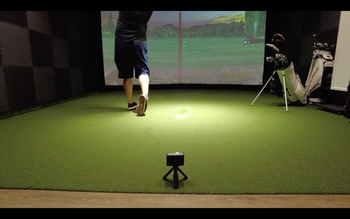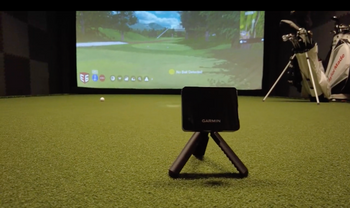So you're eyeing a launch monitor for home use? Listen up, because the space requirements might surprise you.
Before you drop serious cash on one of these bad boys, measure your room like your scorecard depends on it. Nothing worse than unboxing your new toy only to realize it won't work in your setup.
Outdoor setups have their own quirks. Doppler units - think TrackMan style - camp out a good distance behind your tee position. The camera-based ones like GCQuad? They cozy up next to where you're standing. Both need enough real estate for your ball to actually fly and get tracked properly.
Indoor golf gets complicated fast. Say you're thinking about transforming that spare bedroom or unfinished basement. You need answers to critical questions. How much space does your chosen monitor require between you and itself? What's the minimum flight distance needed before your ball smacks into that impact screen while still capturing accurate data?
Converting indoor spaces brings a whole new set of challenges. Sure, you're measuring floor space, but don't forget to look up. Your driver swing arc needs clearance, and nobody wants to explain ceiling dents to their spouse. Been there, done that.
Here's the deal - I'll break down the exact space requirements for all the popular monitors. Whether you're going full country club mode with a complete sim setup or just want a basic net and monitor combo for winter practice, you'll know if it'll work before clicking "buy." Because nothing ruins the excitement of new golf tech faster than realizing your man cave is more like a golf closet.
Table of Contents
FlightScope Mevo+ Setup Space Demands Explained
Getting your Mevo+ dialed in depends on where you're swinging. Let me break down the setup so you can start crushing balls with accurate data.
When You're Hitting Indoors
Your basement or garage setup needs some specific tweaks. You'll want to check that your spin numbers match up with your ball speed properly. Here's the deal - divide your spin rate by your ball speed, and that number better be 11 or higher. So if you're spinning the ball at 2,000 RPM with 180 MPH ball speed, you're sitting pretty at 11.
Got a ratio under 11? Your ball needs more room to fly. While you can squeeze by with 8 feet of flight space, you'll get way better readings with 13 feet. Trust me, those extra 5 feet make a difference when you're trying to dial in your distances.
Taking It Outside
This is where the Mevo+ really shines. Set that bad boy 7 to 9 feet behind where you're teeing up. Make sure you've got open space ahead - no nets, no screens, just pure ball flight. The radar loves tracking that full trajectory when Mother Nature cooperates.
Working on Your Short Game
Want to groove those scoring shots? The Mevo+ has you covered there, too.
For putting practice, find yourself a smooth, flat surface - and here's the kicker - no metallic dots on the ground. Tilt your unit up 12 degrees, park it 7 feet from your ball, and you can track putts anywhere from 6 to 30 feet. Perfect for those clutch par saves you've been working on.
Got limited space for chipping? Grab some metallic dot stickers (or splurge on those fancy Titleist RCT balls). Place the unit 8 feet behind your hitting area, with at least 8 feet to your net. The dots help the radar lock onto those slower-moving chips.
When you've got room to let chips fly naturally - anything under 50 yards - keep that same 8-foot spacing behind the ball. You can track shots from 6 feet all the way out to 50 yards. Great for dialing in those touchy wedge distances.
Heads Up on Interference
Your Mevo+ uses radar technology, so certain things can mess with its tracking. Those buzzing fluorescent lights in your garage? They might cause the same. Go for any electronics sitting between the unit and where your ball's flying. Keep the path clear and you'll get clean data every time.
The bottom line? Whether you're bombing drivers in the backyard or grinding out 10-footers in the basement, proper setup makes all the difference. Get these distances right and you'll have tour-level data helping you lower those scores.
FlightScope Mevo+ Launch Monitor
Experience elite golf technology with FlightScope Mevo Plus - the premium launch monitor transforming home practice with precision data.
SkyTrak+ Launch Monitor & Golf Simulator: Room Size Essentials
Got a chance to test the SkyTrak+ in my backyard last weekend, and here's what you need to know about setting it up outside. First off, forget about space constraints - if you're taking this thing outdoors, you just need enough room to take your normal swing.
Here's the cool part: unlike those bulky launch monitors that sit behind you, this bad boy parks itself off to the side of your ball. You'll actually face the unit when you're standing over your shot. Fire it up and you'll see a red laser dot showing exactly where to tee it up. Pro tip - point that ball logo toward the SkyTrak+ for best results, though it'll work fine either way.
Now, before you start stripping balls off your pristine lawn, hold up. You really want to hit from a proper golf mat if you can. Put your ball right on that laser dot, and you're golden. No match? Tee everything up instead. Trust me on this - hitting irons straight off grass creates a mess of dirt and divots that'll mess with your readings. Nobody wants inconsistent data when you're trying to dial in your distances.
Watch out for bright sunshine too. If the sun's blasting directly into the unit's lens, your shot tracking goes haywire. Just angle it away from direct sunlight and you'll be fine.
Thinking about bringing this indoors when the weather gets nasty? The side-reading setup is clutch for tight spaces. You'll want at least 10 feet from your hitting spot to whatever's in front of you - way less than those behind-the-ball units that need twice that distance.
Width-wise, give yourself 10 feet between walls so you don't put your 7-iron through drywall on the backswing. Been there, done that, had to explain it to the wife.
Ceiling height is where it gets tricky. Nine feet is the bare minimum, but 10 feet lets you really swing freely. Got a buddy who's 6'4" with an upright swing? He's gonna need every inch of that 10-foot ceiling. Meanwhile, if you're more compact or have a flatter swing plane, you might squeeze by with less. Best way to check? Take some slow-motion practice swings with your driver in the space. If you're not scraping the ceiling, you're good to go.
The beauty of this setup is how it adapts to your situation. Backyard session on a nice day? Perfect. Garage setup for winter practice? Works great. The flexibility means you're not locked into one spot, and that side-reading technology saves precious indoor space when you need it most. Plus, getting instant feedback on your shots - whether you're working on that draw or trying to fix your slice - makes practice sessions way more productive than just beating balls at the range.
SkyTrak+ Launch Monitor
SkyTrak+ delivers pro-level launch data and simulation for golfers serious about improvement.
Bushnell Launch Pro: How Much Room Do You Really Need?
You've got plenty of options when setting up your Launch Pro, and that's what makes it such a solid choice for home practice. Want to use it outside? Go for it - whether you're at the driving range or out on the actual course, you'll have all the room you need to let it rip.
Got a backyard net setup? You'll want to make sure your ball travels at least 13 feet before hitting the net. The Launch Pro needs that distance to properly track your shot and give you accurate numbers on ball speed, launch angle, and spin rate.
Bringing it inside changes things up a bit. You'll need a space that's about 14 feet long, 6 feet wide, and 9 feet tall - basically enough room where you won't feel like you're swinging in a phone booth. Nobody wants to worry about clipping the ceiling on their follow-through, right? That mental block alone will mess with your swing mechanics.
Here's the key to getting accurate readings: keep everything level. Your Launch Pro and the ball need to sit on the same flat surface. Think of it like this - if your ball's sitting up on a mat while the device is on concrete, you're gonna get wonky numbers that won't help your game one bit.
Same deal when you're outside. Even though the ground might not be perfectly flat, try to find a spot where both the ball and device are on similar terrain. And watch out for anything that might block the unit's cameras - leaves, grass clippings, or your golf bag sitting too close can all mess with the tracking.
The dual-camera system needs a clear view to capture impact and measure exactly what your club's doing to the ball. That's how it delivers tour-level accuracy that'll actually help you understand why you're hooking your 7-iron or coming up short on approach shots. When you set it up right, you're getting the same data the pros use, just in your garage or backyard.
Bushnell Launch Pro Launch Monitor
Bushnell Launch Pro Launch Monitor delivers pro-level accuracy to transform your practice sessions.
Full Swing KIT: Optimal Area for Seamless Performance
You'll want to start by pulling that back leg out all the way until it's fully extended. Make sure you've got it locked in place before moving on.
Now here's where the magic happens - you're gonna set up your KIT about 10 feet behind where you'd normally tee up. Think of it like placing a caddie directly behind you, except this one won't judge your swing. Just make sure it's sitting on flat ground and lined up straight with where you're aiming.
The cool part? You can actually see your target line right on the device's screen or through the Full Swing app on your phone. If you're using the app, just hop into a practice session, and it'll show you exactly where you're aimed. Flying solo without your phone? No problem - the built-in OLED display has got you covered with the same info.
Before you start crushing balls, take a second to double-check your alignment. The KIT needs a clear view of your entire swing path, so make sure nothing's blocking its line of sight. Trust me, you don't want to set up with a tree or your golf cart in the way - it'll mess with your data big time.
Here's the thing about staying within that target line - if you're hitting from way outside it, the KIT might miss your shot entirely or give you wonky numbers. It's like trying to film your buddy's swing while standing behind a bush. Sure, you might catch some of it, but you're not getting the full picture that'll actually help improve your game.
Full Swing KIT Launch Monitor
Indulge in the ultimate golf experience with the Full Swing KIT, a premium launch monitor.
Garmin R10: Best Practices for Setting Up Your Space
Setting Up Your Garmin R10 Outside
Since this bad boy uses Doppler technology, you're gonna position it behind where you're hitting from. Think of it like having a caddie standing back there tracking your shots.
You'll want about 6-8 feet of clearance between you and the device. Planning to whack balls into a practice net? Give yourself at least 8 feet of ball flight distance after impact - though honestly, more space means better readings on how your shots are actually flying.
Got a hitting mat? Make sure your R10 sits higher than the mat surface. Then comes the fun part - getting everything lined up. See that red laser line on the device? That needs to point straight from your tee through to where you're aiming. Pro tip: lay a club down between the device and your ball to double-check your alignment. It's like creating a runway for your data.
Making It Work Inside Your House
Here's where things get interesting. Since the R10 tracks from behind, you're gonna need some serious room to make this work properly.
For starters, you need at least 14 feet from front to back in your space. That's non-negotiable if you want accurate numbers on your shots. Width-wise, shoot for 10 feet minimum between walls. This gives you room to take a full rip without worrying about putting your 7-iron through the drywall. Plus, since the unit's behind you, both righties and lefties can use the same setup without moving anything around.
Now let's talk ceilings - nothing ruins the vibe faster than smashing your driver into the ceiling on your backswing. You're looking at 9 feet minimum, but 10 is way better. Got a buddy who's 6'4" with an upright swing? They're gonna need even more headroom. Meanwhile, if you're more compact with a flatter swing plane, you might squeeze by with less.
Before you commit to a space, grab your longest club and take some slow practice swings where you plan to set up. Better to find out now than after you've punched a skylight where one shouldn't be.
Garmin Approach R10 Launch Monitor
Garmin Approach R10 brings powerful launch monitoring to your game with unmatched portability.
Rapsodo MLM2PRO: Finding the Perfect Fit for Your Setup
You'll need different setups depending on where you're practicing. Outside, position this thing about 6.5 to 8.5 feet behind where you're hitting from - it should point straight down your target line.
Got an indoor setup? You're looking at just over 14 feet of total space. Here's the breakdown: you need 8 feet between your ball and the net, plus another 6.5 to 8.5 feet behind the ball for the MLM2PRO™. If you're one of those tall guys who really extend through the swing, you might want to scoot it back even more to make sure it catches your whole motion.
Think of it like setting up a camera for slow-mo swing videos, except this bad boy does way more than just record. The key is getting that sweet spot distance where it captures everything from address to follow-through without missing any of the action.
Rapsodo MLM2Pro Launch Monitor
Revolutionize your golf game with the Rapsodo MLM2Pro: unparalleled accuracy meets cutting-edge technology.
FlightScope Mevo: Space Planning for Accurate Results
You'll want to carve out roughly 15 feet of room if you're setting this up indoors. Think of it like creating your own mini driving range in the garage or basement.
Here's the setup that works best: position the unit somewhere between 4 and 7 feet back from where you'll tee up. It's like finding that sweet spot where your buddy stands to watch your swing - not too close, not too far.
Whether you're hitting balls inside or out in the yard, make sure you've got a solid 10 feet of space from your ball position to whatever's stopping those shots - could be a net, impact screen, or whatever barrier you're using. Trust me, you don't want to explain to your spouse why there's a golf ball-sized hole in the wall.
FlightScope Mevo
FlightScope Mevo delivers professional-grade swing data for ultimate practice precision.
Swing Caddie SC300i: Creating the Ideal Environment
You'll want to position yourself about 6 feet back from where you're hitting - that's the sweet spot for getting accurate readings. Got a tight space in your garage or basement? No worries, you can squeeze it down to 4 feet and still get solid data. Now, if you're one of those bombers who swings out of their shoes, better scoot that unit back to 7 feet so it can properly track your missiles.
Here's the thing - you've gotta keep that space between your Mevo and the hitting area completely clear. No golf bags, no buddies walking through, nothing. Think of it like the landing strip at an airport - it needs to be wide open for the radar to do its job.
For dialing in your spin rates (which is huge for understanding why your shots balloon or fall out of the sky), slap one of those metallic dots on your ball. Just make sure that the shiny sticker faces away from the unit when you set up. It's like giving the radar a target to lock onto, and trust me, the difference in spin accuracy is night and day.
One last setup tip that most people miss - keep your Mevo at the same height as where your ball sits. If you're hitting off a mat that's raised or using a hitting platform, adjust the device to match. When everything's level, you're getting tour-quality data instead of wonky numbers that'll have you scratching your head.
Voice Caddie Swing Caddie SC300i Launch Monitor
Voice Caddie SC300i Launch Monitor gives real-time swing data with voice feedback and pro precision.
Frequently Asked Questions
What are the minimum room dimensions needed for most golf launch monitors?
Most home golf simulator setups require at least 18 feet of depth, 14 feet of width, and 10-foot ceilings to accommodate a wide range of launch monitors and allow for a comfortable swing. Some setups may work with less space, but these dimensions are ideal for versatility and safety.
How do space requirements differ between radar and photometric launch monitors?
Radar-based launch monitors typically require more depth, as they are placed 6–10 feet behind the golfer to track ball flight accurately. Photometric launch monitors, on the other hand, are usually positioned next to or above the hitting area and require less depth, making them better suited for tighter spaces.
Why does ceiling height matter for indoor golf simulators?
A minimum ceiling height of 9 feet is generally recommended to allow for a full, unrestricted swing with all clubs. Taller ceilings (10 feet or more) provide additional comfort, especially for taller players or those using longer clubs.
How does the hitting area size of a launch monitor affect simulator flexibility?
A larger hitting area (width and length) allows golfers to hit from various positions, accommodating both right- and left-handed players without moving the unit. It also extends the lifespan of the hitting mat by distributing wear more evenly.
What are the space requirements for popular budget-friendly launch monitors?
Entry-level models like the Garmin R10 require the unit to sit 6–8 feet behind the golfer, making them suitable for moderately sized rooms or garages. Their compact design and portability make them flexible for both indoor and outdoor use.
What Are the Swing Caddie SC300i Space Requirements?
You'll want to set up your SC300i about 5 feet directly behind where you're hitting from, making sure it's sitting on the same surface as your ball. Think of it like your personal caddie standing back there tracking every shot.
Here's the thing - this launch monitor needs that specific distance to accurately capture your ball flight data. Too close and you'll get wonky readings. Too far back and it might miss some shots entirely. That sweet spot at 5 feet gives you the most reliable numbers for your swing speed, carry distance, and ball speed.
If you're practicing indoors with a net (which tons of us do when the weather turns nasty), you'll need at least 6 and a half feet between your hitting position and the net. Any closer and the monitor won't have enough time to track the ball properly before it smacks into the net. Plus, you probably don't want to be standing that close to a ball rocketing back at you anyway!
The beauty of this setup is how simple it is. No alignment sticks, no complicated calibration - just plop it down behind you and start swinging. It's actually tracking your ball using Doppler radar technology, which is the same stuff they use for weather tracking, except now it's following your 7-iron instead of storm clouds.
What I really dig about this distance requirement is that it works perfectly with most practice spaces. Whether you're at the range, in your garage, or out on the course doing some field testing, that 5-foot spacing is easy to eyeball and gives you consistent data every time.













